Unit 7 Weather 单元分析教学设计
《weather》教学设计

- 69 -校园英语 / 职业教育研究《weather》教学设计黑龙江省五常职教中心/许冰滢一、教材分析1.教材编写意图、地位与作用。
本教材是语文出版社出版的,中等职业教育课程改革国家规划新教材基础模块上册unit 6 weather 中的第一课时,本节内容讲解天气,学生对这个话题大都比较熟悉,也会相对的感兴趣,学习欲望会比较强烈。
2.教学对象分析。
职业学校的学生基础较差,语言技能的应用情况不好。
我班大部分学生虽然有表现的欲望,但缺乏自信心,因此,我以亦师亦友的身份走进他们,以基础的语言启发他们,以轻松的谈话引导他们,愉快的展开合作。
3.教学目标(1)知识目标:1)词汇:March May hometown quite field grow turn green ...2)短语:in the fields come out plant trees ...3)句型:... is/are good for ... Summer comes after spring. (2)能力目标:1)掌握描述天气的基本表达方式,运用How ’s the weather today?/What ’s the weather like today?等进行表达.2)掌握关于四季的基本内容及语言点,能较流畅的朗读课文和复述课文。
(3)情感目标:1)激发学生学习兴趣和创造能力;2)通过小组互助学习,培养团队精神。
4.教学重点,难点(1)重点:描述天气的词汇,一年四季和十二个月份的词汇。
(2)难点:口头表达描述天气和谈论季节。
二、教法和学法教法:以“任务驱动、分层教学”等教学方法,以“任务”为主线,采用“明示目标,展示任务→知识讲解,分析任务→分组训练,练习任务等形式,突出教师主导,学生主体的教学理念;学法:(1)多媒体互动教学手段,使学生在头脑中加深理解,巩固所学知识。
(2)教师精讲、学生通过实例学习,理解并发现问题。
(3)小组为单位组织教学,自主学习与协作学习相结合。
Unit 7 It’s raining. 大单元整体教学设计
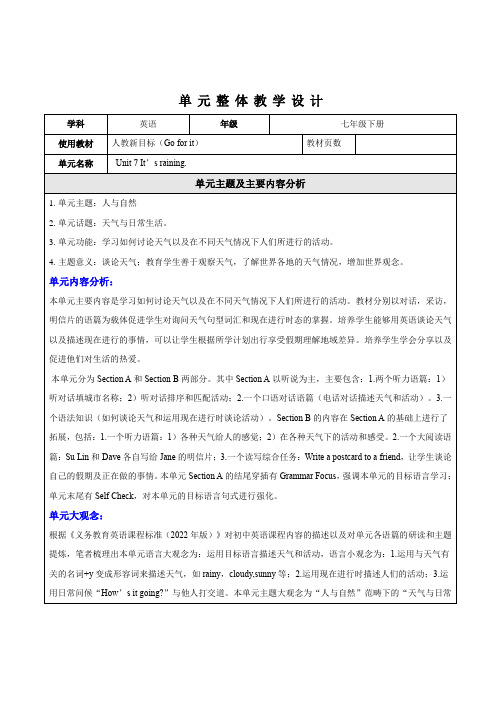
单元整体教学设计
活动”。
通过整合,笔者将Section A 1a-1c作为第一课时,提炼课时子主题为“世界主要国家与城市的天气”;将Section A 2a-2d和Section B1a-1e作为第二课时,提炼课时子主题为“同伴交往与文化自信”;将Grammar Focus-3b作为第三课时,提炼课时子主题为“生活与学习”;将Section A 2a-2d及Section B 1a-1e 作为第四课时,提炼课时主题为“不同生态地区的生态特征与自然景观”。
此外,笔者还增加了两篇拓展阅读材料和一个综合实践任务,作为第五课时,提炼课时主题为“热爱与敬畏自然,与自然和谐共生”。
单元主题框架结构图如下:
单元核心语篇分析:。
新译林版英语八年级上册Unit7整个单元教案
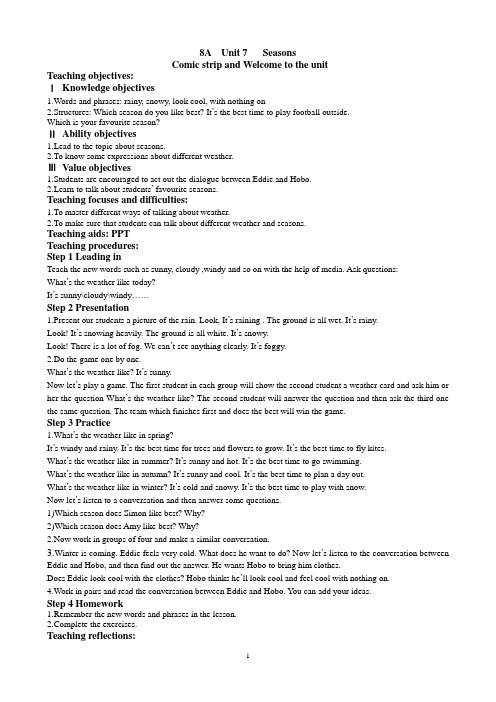
Comic strip and Welcome to the unitTeaching objectives:ⅠKnowledge objectives1.Words and phrases: rainy, snowy, look cool, with nothing on2.Structures: Which season do you like best? It’s the best time to play football outside.Which is your favourite season?ⅡAbility objectives1.Lead to the topic about seasons.2.To know some expressions about different weather.ⅢValue objectives1.Students are encouraged to act out the dialogue between Eddie and Hobo.2.Learn to talk about students’ favourite seasons.Teaching focuses and difficulties:1.To master different ways of talking about weather.2.To make sure that students can talk about different weather and seasons.Teaching aids: PPTTeaching procedures:Step 1 Leading inTeach the new words such as sunny, cloudy ,windy and so on with the help of media. Ask questions:What’s the weather like today?It’s sunny\cloudy\windy……Step 2 Presentation1.Present our students a picture of the rain. Look, It’s raining . The ground is all wet. It’s rainy.Look! It’s snowing heavily. The ground is all white. It’s snowy.Look! There is a lot of fog. We can’t see anything clearly. It’s foggy.2.Do the game one by one.What’s the weather like? It’s sunny.Now let’s play a game. The first student in each group will show the second student a weather card and ask him or her the question What’s the weather like? The second student will answer the question and then ask the third one the same question. The team which finishes first and does the best will win the game.Step 3 Practice1.What’s the weather like in spring?It’s windy and rainy. It’s the best time for trees and flowers to grow. It’s the best time to fly kites.What’s the weather like in summer? It’s sunny and hot. It’s the best time to go swimming.What’s the weather like in autumn? It’s sunny and cool. It’s the best time to plan a day out.What’s the weather like in winter? It’s cold and snowy. It’s the best time to play with snow.Now let’s listen to a conversation and then answer some questions.1)Which season does Simon like best? Why?2)Which season does Amy like best? Why?2.Now work in groups of four and make a similar conversation.3.Winter is coming. Eddie feels very cold. What does he want to do? Now let’s listen to the conversation between Eddie and Hobo, and then find out the answer. He wants Hobo to bring him clothes.Does Eddie look cool with the clothes? Hobo thinks he’ll look cool and feel cool with nothing on.4.Work in pairs and read the conversation between Eddie and Hobo. You can add your ideas.Step 4 Homework1.Remember the new words and phrases in the lesson.plete the exercises.Teaching reflections:Reading 1Teaching objectives:ⅠKnowledge objectives1.Words and phrases: shower, upon, as, temperature, drop, rise, be full of, forget to grow, fly far away, among flowers, turn brown, fall into piles upon the ground, harvest crops2.Structures: What a perfect time to fly a kite! Farmers work to harvest crops, as the days are shorter and the temperature drops.ⅡAbility objectives1.To guess general meanings from keywords and context2.To understand the main points of the reading passages.ⅢValue objectivesWhatever you do, you should try your best, then your life will be as colourful as seasons. Enjoy your life. Teaching focuses and difficulties:1.To identify specific information about different people form the poem2.To use words to describe the change of the four seasonsTeaching aids: PPTTeaching procedures:Step 1 Warm-upWhat’s your favourite season? Why?I like winter . It often snows in winter. It’s the best time to play with snow.Step 2 Pre-reading1.T: Spring is the best season of the year. It’s warm and windy. It’s the best time to fly kites. Bees and butterflies play among flowers.2.If the rain comes, they hide from the April showers.3.Summer is hot ,but we can enjoy a long summer holiday. What can we do in summer? We can go swimming. We can eat an ice cream. There are also quiet streams, trees and shade. I like chatting or reading in the middle of the day. The temperature rises quickly at that time.4.What colour are the leaves? They are yellow, red, golden and brown. In autumn, the leaves turn brown. They fall into piles upon the ground. It’s the best time for farmers to harvest crops.5.As the days are shorter and the temperature drops, winter is coming. It’s cold in winter. Sometimes it’s snowy. The ground is covered with snow. Birds fly far away.Step 3 While-reading1.Now please open your books and turn to page 83.Look at Part B2.We are going to listen to the poem. Write down the correct seasons in the blanks. Then match each season with the description in the poem.It’s spring. What a perfect time to fly a kite! Bees and butterflies play among flowers.It’s autumn. Brown leaves fall on the ground. Farmers harvest crops.It’s winter. Winter days are full of snow. Birds fly far away.It’s summer. There are quiet streams, trees and shade. We can eat ice cream.2.What can we see in winter?Can trees and flowers grow in winter?Why do the birds fly far away?What can we do in spring?What do bees and butterflies do in spring?What can we do in summer?Where can we often play in summer?Where can we see piles of autumn leaves?What are the farmers busy doing in autumn?Read the poem again and find the rhyming words.Read the poem again ,and then discuss and find the sentences in which the writer uses personification.Step 4 Post-reading1.Please repeat the poem after the tape. Pay attention to your pronunciation and intonation.Please read the poem together and express your feelings about each season.I’m going to divide you into four groups. Each group will read one of the seasons.2. Which season do you like best? Why?Step 5 Homework1.Read the poem correctly and fluently.plete the exercises.Teaching reflections:8A Unit 7 SeasonsReading 2Teaching objectives:ⅠKnowledge objectives1.Words and phrases: shower, upon, as, temperature, drop, rise, be full of, forget to grow, fly far away, among flowers, turn brown, fall into piles upon the ground, harvest crops2.Structures: What a perfect time to fly a kite! Farmers work to harvest crops, as the days are shorter and the temperature drops.ⅡAbility objectives1.To revise vocabulary and expressions to describe seasons2.To guess meaning from context3.To focus on the language pointsⅢValue objectivesWhatever you do, you should try your best, then your life will be as colourful as seasons. Enjoy your life. Teaching focuses and difficulties:1.Words and phrases: shower, upon, as, temperature, drop, rise, be full of, forget to grow, fly far away, among flowers, turn brown, fall into piles upon the ground, harvest crops2.Structures: What a perfect time to fly a kite! Farmers work to harvest crops, as the days are shorter and the temperature drops.Teaching aids: PPTTeaching procedures:Step 1 RevisionT: We have learnt some words to describe the seasons. Can you describe each season with the words in the poem and introduce your favourite season to us? Others please guess which season it is?Ask 3-4 Ss to read their articles.Step 2 PracticeWhat can we see in winter? Can trees and flowers grow in winter? Why do the birds fly far away?What can we do in spring? What do bees and butterflies do in spring?What can we do in summer? Where can we often play in summer?Where can we see piles of autumn leaves? What are the farmers busy doing in autumn?Step 3 Explanationbe full of =be filled withforget to do sth, forget doing sthWhat a perfect time toWhat a perfect time to go on a trip!What a perfect time to go swimming!What a perfect time to walk by a stream!drop: to become or make sth weaker, lower or lessThe price of the car has dropped a little.Rise: to come or go upwards; to reach a higher level or positionThe river has risen by several meters.shower: a short period of rain or snowThere will be showers this afternoon.temperature: a measure of how hot or cold it isWinter has come and the temperature has dropped below zeroupon: onHe set the plates upon the table.Step 4 ActivitiesWhich season do you like best? Why?Please make a poster about your favourite season.Please come to the front. Show us your favourite season.Nature is full of pleasure and beauty. We should protect nature and make our world more beautiful.Step 5 Homework1.Remember words, phrases and sentences.plete the exercises.Teaching reflections:8A Unit 7 SeasonsGrammarTeaching objectives:ⅠKnowledge objectives1.Words and phrases: cloud, kick, fever, cough, awful, from morning till night, kick the ball, have a high fever, cough a lot, an awful day2.Structures: The clouds become dark. Luckily, it didn’t rain.ⅡAbility objectives1.To master the usage of different kinds of verbs2.To learn to use intransitive verbs, transitive verbs, linking verbsⅢValue objectivesAt the end of the lesson, the students will be able to talk about different weather and seasons.Teaching focuses and difficulties:1.Words and phrases: cloud, kick, fever, cough, awful, from morning till night, kick the ball, have a high fever, cough a lot, an awful day2.Structures: The clouds become dark. Luckily, it didn’t rain.Teaching aids: PPTTeaching procedures:Step 1PresentationT: We are going to look at three sentences. Pay attention to the verbs.1.The snowy season will begin.2.Children can eat ice cream.3.The autumn leaves turn brown.They are three kinds of verbs. They are intransitive verbs, transitive verbs and linking verbs.An transitive verb does not take an object, but can have a prepositional phrase after itA transitive verb takes an object.A linking verb links the subject and the adjective phrase that describes it.Linking verbs: be, become, feel. get. look, seem, sound, stay, smell, taste, turnAn intransitive verb does not take an object, but can have a prepositional phrase after itA transitive verb takes an object.A linking verb links the subject and the adjective phrase that describe it.Step 2 PracticeRead these sentences. Pay attention to the underlined verbs. Which are transitive verbs? Which are intransitive verbs? And which are linking verbs?1.My sister works.2.Lucy is reading a book.3.My father bought me a new bike.4.The students keep healthy by cycling at weekends.5.Where does the boy live?6.The fish tastes delicious.7.A terrible traffic accident happened on a rainy evening.8.I am a member of the dancing club.Step 3 ConsolidationWe’ve learned about three kinds of verbs. Each word or phrase after a verb plays a different role in the sentence because of the type of the verb.1 The boy is swimming.S+V2Sandy watches clouds.S+V+O3The film was interesting.S+V+PIntransitive verb: S+VTransitive verb:S+V+OLinking verb: S+V+PStep 4 Homework1.Review Grammar.plete the exercises.Teaching reflections:8A Unit 7 SeasonsIntegrated skillsTeaching objectives:ⅠKnowledge objectives1.Words and phrases: wind, around, rest, degree, bit, blow, loud, ring, turn more cloudy, in the future, the rest of2.Structures: How are you doing?ⅡAbility objectives1.To listen to the tape for specific information that they need to complete a table.2.To help the students develop the ability to recognize the keywords and grasp the main points of a listening material.ⅢValue objectivesAt the end of the lesson, the students will try to make a weather report in English.Teaching focuses and difficulties:1.To response to information abstained from listening and reading.2.To develop the ability to organize the information they get through listening.Teaching aids: PPTTeaching procedures:Step 1 PresentationHelp the students to revise the sentence structures.China is a big country. In the south of China, it’s warm in winter. But in the north, it’s cold in winter.Look at the pictures of Australia. The beaches there are very famous .Do you like going to the beach to lie in the sun and eat ice cream?In Australia, you can go to the beach and enjoy the sunshine in December. When it’s winter in China, it’s summer in Australia.Step 2 ListeningNow we’re going to listen to the weather report about four cities. Listen carefully and complete the table on page 87.Listening A3.Annie is writing about the weather in different places in her diary entry. Listen to her conversation with Simon. Help her complete her diary entry.Step 3 PracticePlay in groups. One is a reporter , the other is a student.Winter in the north of China always seems to be so snowy. There’ll be a strong snowstorm in Beijing. It’s very cold. The lowest temperature will be minus twelve degrees. Winter in the south of China is warm. The temperature will stay above zero, between twenty-five degrees and eighteen degrees in Haikou, so it won’t snow there.Provide some possible questions1What will the weather be like in Beijing?2What will the weather be like in Haikou?3What will the weather be like……?Step 4 Homework1.Remember the words, phrases and sentences.plete the exercises.Teaching reflections:8A Unit 7 SeasonsStudy skillsTeaching objectives:ⅠKnowledge objectives1.Words and phrases: sleep, shine, sudden, fight, make them look funny, make people sleep, the sudden heavy rain, snowball fights2.Structures: Many people in the street have to cover their faces with scarves. The high temperature makes people sleepy in the afternoon. The sudden heavy rain causes a lot of problems.ⅡAbility objectives1.To learn the prefixes -y2.To find the main points of a passage in order to understand and memorize it more easily.ⅢValue objectives1.To give the students a chance to practise their spoken English2.To identify keywords in order to develop general understanding of a passage3.To guess the meaning and generate mental picturesTeaching focuses and difficulties:e the new words to make a new sentence.2.Pay attention to the spelling of each word.Teaching aids: PPTTeaching procedures:Step 1 Presentation1.Help the students to revise the sentence structures:S+VS+V+OS+V+PS+V+IO+DOS+V+DO+OC2.Look at the picture. It’s cloudy. Can you describe the other pictures.It’s windy\rainy\snowy.cloud-cloudy wind-windy rain-rainy snow-snowy sun-sunny fog-foggy3.Have luck means lucky.health\sleep\shine\noise\funHave health means healthy.Have sleep means sleepy.Have shine means shiny.Have noise means noisy.Have fun means funny.Step 2 PracticeComplete Millie’s article with the help of the pictures and the words in the box.Read the article together, please.Step 3 ActivityPlay in groups. One is a reporter, the other is a student.Winter in the north of China always seems to be so snowy. There’ll be a strong snowstorm in Beijing. It’s very cold. The lowest temperature will be minus twelve degrees. Winter in the south of China is warm. The temperature will stay above zero, between twenty-five degrees and eighteen degrees in Haikou, so it won’t snow there.Provide some possible questions1What will the weather be like in Beijing?2What will the weather be like in Haikou?3What will the weather like……?What’s the weather like in spring?It’s so___. Many people have to cover their faces with scarves. It makes them look___.What’s the weather like in summer?It’s usually very hot. People feel ____in the afternoon. Sometimes it’s ____, the sudden heavy rain causes many problems.How’s the weather in autumn?People are_____ to enjoy many ____days. They like to travel around the city in such weather.Step 4 Homework1.Remember some important words, phrases and sentences.plete the exercises.Teaching reflections:8A Unit 7 SeasonsTaskTeaching objectives:ⅠKnowledge objectives1.Words and phrases: deep, land, exciting, throw, ice, everywhere, be covered in deep white snow, during this season, throw snowballs at each other, use carrots for their noses2.Structures: The lakes and rivers are frozen. We throw snowballs at each other, screaming and laughing.ⅡAbility objectives1.The students should learn how to arrange a passage according to the writing topic.2.At the end of the lesson, the students should have a general idea about writing.ⅢValue objectivesAt the end of the lesson, the students will be able to talk about different weather and seasons.Teaching focuses and difficulties:1.Words and phrases: deep, land, exciting, throw, ice, everywhere, be covered in deep white snow, during this season, throw snowballs at each other, use carrots for their noses2.Structures: The lakes and rivers are frozen. We throw snowballs at each other, screaming and laughing. Teaching aids: PPTTeaching procedures:Step 1 Lead-inIn this unit, we have learnt a lot about how to describe seasons.1Which season is it in the pictures?2What is the weather like?It’s cold and snowy.3What do people wear?They wear thick warm clothes.4What are people doing?They are making snowmen and having big snowball fights.5What are the rivers and lakes like?Step 2 ReadingHarbin is a city of ice and snow. Winter in Harbin is amazing. Simon is reading an article about it on the Internet. Read the article quickly and find the answers to these questions.1Which season does the author like best?2Why does the author like in winter?3What is the weather like?4Can you see beautiful flowers and green trees during this season?5What else does the author enjoy in winter? why?Step 3 Writing1What is your favourite season?2What is the weather like then ?3 What does your city look like then?4Why do you like this season?5What activities do people enjoy doing in this season?Brainstorming:When you want to talk about sth, what do you feel difficult to do? Proper words and phrases.So we need to gather enough words about sth. when we want to talk about it. How many words do you know that we can use to describe our friends? Let’s do it in groups. Please show us you are the best.Step 4 Homework1.Choose one of the topics and write your own passage.plete the exercises.Teaching reflections:。
人教版七年级英语下册第七单元教案
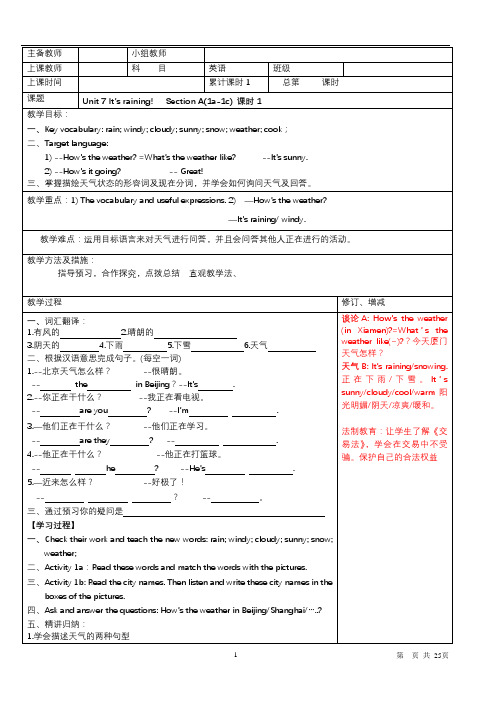
七年级(下)第7单元第3课时Unit7 It’s raining!Section B (1a-1e)七年级(下)第7单元第4课时Unit 7 It’s raining!Section B(2a-3c)七年级(下)第7单元第5课时Unit 7 It’s raining!Self checkUnit 7 It’s raining! Self check四、【教后反思】九年级英语上册期末试卷学校____________________ 姓名__________________ 准考证号__________________听力理解(共30分)一、听对话,从下面各题所给的A、B、C三个选项中选择与对话内容相符的图片。
每段对话你将听两遍。
(共5分,每小题1分)1.A.B. C.2.A.B.C.3.A.B. C.4.A.B.C.5.A.B.C.二、听对话或独白,根据对话或独白的内容,从下面各题所给的A、B、C三个选项中选择最佳选项。
每段对话或独白你将听两遍。
(共15分,每小题1.5分)请听一段对话,完成第6至第7小题。
6. What day is better for the boy to do sports?A. Monday.B. Tuesday.C. Wednesday.7. What sport does the boy like?A. Volleyball.B. Basketball.C. Tennis.请听一段对话,完成第8至第9小题。
8. What are the speakers mainly talking about?A. School life.B. Family members.C. People at the party.9. What is Jenny like?A. She is friendly.B. She is boring.C. She is quiet.请听一段对话,完成第10至第11小题。
unit7 Nice Weather, Nice Mood
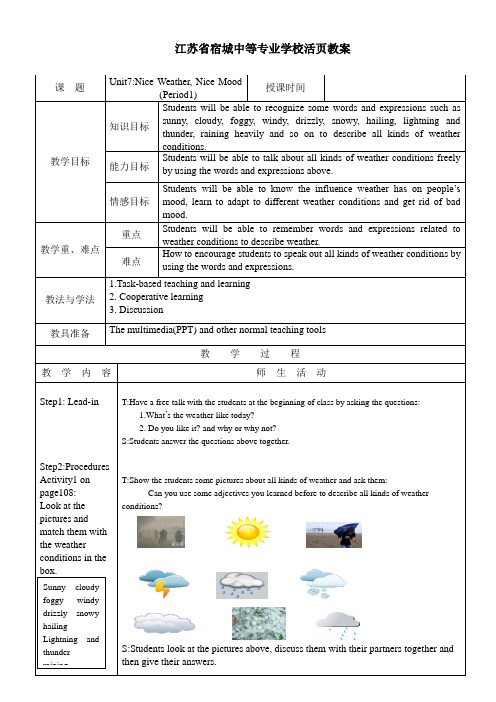
江苏省宿城中等专业学校活页教案课题Unit7:Nice Weather, Nice Mood(Period1)授课时间教学目标知识目标Students will be able to recognize some words and expressions such assunny, cloudy, foggy, windy, drizzly, snowy, hailing, lightning andthunder, raining heavily and so on to describe all kinds of weatherconditions.能力目标Students will be able to talk about all kinds of weather conditions freelyby using the words and expressions above.情感目标Students will be able to know the influence weather has on people’smood, learn to adapt to different weather conditions and get rid of badmood.教学重、难点重点Students will be able to remember words and expressions related toweather conditions to describe weather.难点How to encourage students to speak out all kinds of weather conditions byusing the words and expressions.教法与学法1.Task-based teaching and learning2. Cooperative learning3. Discussion教具准备The multimedia(PPT) and other normal teaching tools教学过程教学内容师生活动Step1: Lead-in Step2:Procedures Activity1 on page108:Look at the pictures and match them with the weather conditions in the box. T:Have a free talk with the students at the beginning of class by asking the questions:1.What’s the weather like today?2. Do you like it? and why or why not?S:Students answer the questions above together.T:Show the students some pictures about all kinds of weather and ask them:Can you use some adjectives you learned before to describe all kinds of weather conditions?S:Students look at the pictures above, discuss them with their partners together and then give their answers.Sunny cloudy foggy windy drizzly snowy hailing Lightning and thunder rainingActivity2:Put the weather conditions above into four seasons groups.In spring:______________ In summer:______________ In autumn:______________ In winter:______________ Activity3:V ocabulary on page118 T:On the basis of activity1, the teacher asks students what kind of weather often comes in spring , summer, autumn, and winter. and then ask them to put the weather conditions above into four seasons groups so that they finish Activity2.S:Students give their answer according to activity1.T:Different kinds of weather have different influence on life. What activities do you usually do in different weather? In order to take part in these activities, What things do you want to take with you? Let read the following chart and add words of your own to make it bigger.kinds ofweatherrainy snowy windyactivitiesactivitiessunnythings totake withyouactivitiesthings totake withyouthings totake withyouff goswimming sunglassesmake asnowman a scarfhhave a picnicj e rActivity4:Real Life Skills1.Describe the weather condition according to the pictures2.Describe the weather in your town/city and know the 72-hour weather forecast say. If possible, students and draw simple pictures. S:Students discuss with each other and answer.T:Show students to look at the pictures given in the following table, try to describe this kind of weather condition and write them down.S:Write the weather condition down according to the words in activity1 one by one.The Current Weather April26Weather:_________11℃~21℃Wind :southeast wind,4-5levelsUV light strength: highAir quality: good72-Hour Weather ForecastApril27 April 28 April 29Weather: sunny to cloudy14℃~26℃Level 4-5 southeastwindWeather:______________________18℃~32℃Level 4-5 southeastwindWeather: ______________17℃~26℃Level 3-4 south windT:Let the students describe the weather in their town/city. If possible, draw simple pictures according to the weather forecast.S:Students describe and try to draw it according to requirements.The Current WeatherWeather:___________Temperature:________Wind:_______________UV light strength:___________Air quality:______________72-Hour Weather ForecastDate:_________ Date:__________ Date:______________Weather:_____________Temperature:__________Wind:_______________Weather:___________Temperature:________Wind:______________Weather:_______________Temperature:___________Wind:_________________ picturepicture picture pictureStep3:Homework1.Remember the adjectives related to weather conditions2.Talk about the weather according to different weather conditions3. Preview the new words and expressions in Listening and speaking板书设计Unit7:Nice Weather, Nice Mood(Period1) Adjectives related to weather conditions:sunny cloudy foggywindy drizzly snowyhailing raining heavilylightning and thunder……教学后记。
人教版初中七年级英语下册第七单元Unit 7 教案含教学反思

第7单元It’s raining!类别课程标准要求掌握的内容话题The weather 天气Section A 单词rain v.下雨n.雨水windy adj.多风的cloudy adj.多云的sunny adj.晴朗的snow v.下雪n.雪weather n.天气cook v.做饭bad adj.坏的;糟的park n.公园message n.信息;消息him pron.他(he的宾格)could modal v.能;可以back adv.回来;回原处problem n.困难;难题again adv.再一次;又一次Moscow 莫斯科Toronto 多伦多Boston 波士顿短语ake a message 捎个口信;传话call (sb.) back (给某人)回电话no problem 没问题have a good time 玩得开心right now 此刻;马上句型1.—How’s the weather? 天气怎么样?—It’s cloudy. /It’s sunny. /It’s raining. 多云。
/ 晴朗。
/ 正在下雨。
2.—How’s it going? 近来可好?—Great! / Not bad. /Terrible! 好极了!/ 还不错。
/ 糟透了!句型1. I’m having a great time visiting my aunt in Canada. 我在加拿大看望我的姑妈,并且玩得很开心。
2. My family and I are on a vacation in the mountains. 我和我的家人正在山里度假。
3. It’s hot in your country now, isn’t it ?你们的国家现在很热,对吗?4.The weather here is cool and cloudy, just right for walking.这儿的天气凉爽且多云,正适合散步。
七年级《go_for_it》Unit7_It’s_raining.教学设计与反思
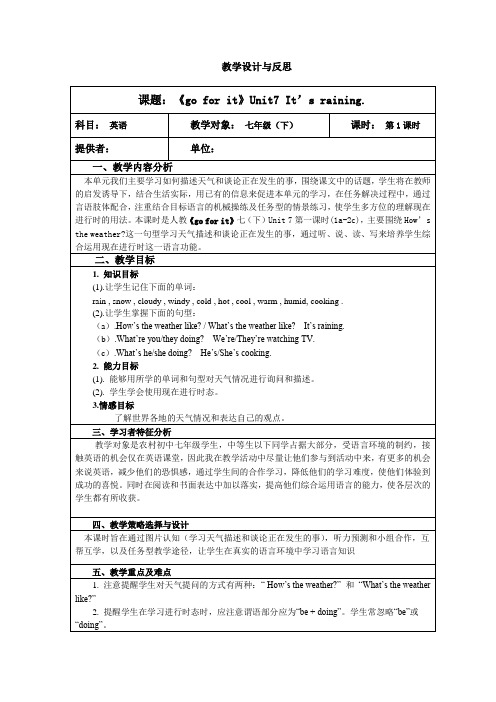
教学设计与反思the sample answer for number 1. Correct the answers 2b.Check the answers 2b. 8.Homework根据听力2a2b ,写一篇Uncle Joe 一家的活动,文章开头给出:This is Uncle Joe ’s family. It ’s 6:00 pm. Uncle Joe is ------.这是检验学生对这堂听力课堂理解的延续巩固学习。
七、教学评价设计八、板书设计九.教学反思本节课中心话题是谈论天气,涉及两个主要的语言功能项目:一是运用How’s theweather? 及描述天气情况的形容词;二是继续运用现在进行时来描述人们的即时活动。
我在充分考虑了学生的语言基础,设计了操作性很强的语言活动,开始我主要是通过图片了然的解决描绘天气的生词,克服了学生记单词的心理障碍。
然后,我设计猜天气并和地点城市结合的游戏,活跃气氛,激发兴趣。
所以处理Section A 1b 的听力部分,学生不会有问题。
接着2a2b 的听力时围绕上一单元学过的的现在进行时,我是用听前-听中-听后的方法处理,不同层次的学生都有成功的体验。
同时创设了听力延续巩固练习,在整个教学设计和过程实施中做到了环环相扣,层层推进,课本教学内容和任务是非常好的完成了。
虽然经过我的精心设计,在循序渐进的呈现和练习中,学生由大量的语言输入和内化的机会,但是备课时考虑还是不够全面,活动设计还不够有效,教学方法还不够新颖灵活,学生知识的拓展延伸方面设计的不够好。
在教学路上,且行且思,且思且行。
我会在今后的教学路上,发扬优点,改进缺点,争做学生、家长、学校满意的人民教师。
Sunnyrainy/rainingcloudySnowy/snowingwindyHow ’ s the weather?=What ’s the weather like?is calling is cookingis watching TV Be +doing is playing computer games is talking on the phone。
weather 教学教案设计

weather 教学教案设计weather 教学教案设计篇一:weather 教学设计《Weather》一、概述·《Weather》是闽教版小学英语第三册第六单元第十一课。
·本篇课文所需课时为一课时,40分钟。
·本课主要学习sunny,cloudy,rainy,snowy等四种基本天气情况及“How is the weather today? It’s a…day.”等句型并能在实际情况中应用。
本课内容是本单元的重点,学生掌握好基本的认读,学习了重点句型,将为接下来的进一步学习打下了基础,也有助于培养学生能够在实际情景中谈论天气能力,提高综合运用语言的能力。
二、教学目标分析1.教学目标知识与技能:·听懂会说会写weather,sunny, rainy, cloudy,snowy ·听懂会说How is the weather today? ----It s a sunny day.How is the weather in Beijing? ----It’s a sunny day.·能够在实际情景中运用以上句型谈论天气。
过程与方法:·在生词的教学中,通过游戏、竞赛、当小老师、两人小组活动多种形式,活化了操练的形式,用听、说、做、练相结合的方法来使学生掌握本课的生词。
·在学生已充分掌握生词和句型的基础上,让学生进行猜天气的游戏及充当气象员的情景表演,让学生进行对话操练,巩固所学的内容,提高学生口语交际能力。
情感态度与价值观·增进学生对天气的观察,增加对学生大自然的热爱,培养学生热爱生活品质。
·激发学生学习英语的兴趣,培养他们的合作精神。
2.教学重难点教学重点:学生可以读、写、说出并且听懂weather,snowy, sunny, cloudy, rainy等词语及How is the weather today?句型。
含有课后反思的Unit7How's the weather

本堂课的教和学均围绕本堂课的三个目标开展实施。
巧设导入,用一首有关天气的英文歌“How is the weather?”进行导入,英文歌曲不仅正切入所授内容,也恰到好处地调节了学生的情绪,即培养了学生学习英语的兴趣,又营造了一个积极生动的学习氛围。
本节课在教学模式中采用任务型教学法,在授课过程中应用了游戏法,分组合作法、启发诱导法,演唱教学法。
教学设计按照老师:创设情景――激发兴趣――组织活动――指定目标学生:交流探究――合作活动――锻炼能力――升华习惯,使全体同学在充分的活动中学到了新的知识,取得了较好的教学效果。
本节课让学生在上课时就明确学习目标,使其学习有方向,激发其学习动机,调动其学习积极性,从而促进学生在以后各个环节里主动地围绕目标探索、追求。
比如在2b中,主要是复习天气的表达和现在进行时,这为2a和2c即学习2b起着承上启下的作用。
单词和短语的学习我安排在预习中,在2b中让学生掌握postcard的书写方法,在2c中,通过填写表格,让学生查找文章的细节,从而即培养了学生的阅读能力,又复习了现在进行时。
语言是思维的工具,思维需要语言进行表达,从而应用于课堂中。
如果一味地进行机械式的操练容易限制学生内在潜能的发挥,因此,教师应该不断改变自己的教学观念,在课堂中努力创造条件鼓励学生发散思维,督促学生灵活地去思考,让学生在教师“指南针”的“领航”中放开思绪,驰骋在想像的海洋中;让课堂教学由原来的学生不想说、不会说到现在的学生乐说会说、思如泉涌;让学生懂得展开想像的翅
膀,在天空中自由自在的飞翔!。
人教PEP版英语四年级下册Unit3《Weather》单元教学设计

人教PEP版英语四年级下册Unit 3《Weather》单元教学设计一. 教材分析人教PEP版英语四年级下册Unit 3《Weather》主要介绍了天气相关的词汇和句型。
通过本单元的学习,学生能够掌握有关天气的词汇,如sunny, cloudy, rny, windy等,并能用英语描述天气情况。
教材内容丰富,贴近生活,有利于激发学生的学习兴趣。
二. 学情分析四年级的学生已经具备了一定的英语基础,能够听、说、读、写一些简单的英语句子。
但在本单元的学习中,学生需要掌握一些关于天气的新词汇,以及如何用英语描述天气情况。
因此,在教学过程中,教师需要关注学生的个体差异,给予不同程度的学生适当的帮助。
三. 教学目标1.知识目标:学生能够掌握有关天气的词汇,如sunny, cloudy, rny,windy等;能够用英语描述天气情况。
2.能力目标:学生能够听、说、读、写关于天气的英语句子,提高英语表达能力。
3.情感目标:通过本单元的学习,学生能够关注天气变化,学会关爱自己和他人。
四. 教学重难点1.重点:掌握有关天气的词汇和句型。
2.难点:如何用英语准确地描述天气情况。
五. 教学方法1.情境教学法:通过设置各种天气情境,让学生在实际语境中学习、运用英语。
2.游戏教学法:运用 weather 相关的游戏,激发学生的学习兴趣,提高学生的参与度。
3.任务型教学法:引导学生参与各种 weather 相关的任务,培养学生的合作意识和实际运用能力。
六. 教学准备1.教学课件:制作与 unit 3《Weather》相关的课件,包括 weather 词汇和句型的呈现、练习等。
2.教学素材:准备与 weather 相关的图片、视频等素材,用于课堂展示和练习。
3.作业设计:设计具有针对性的作业,巩固所学知识。
七. 教学过程1.导入(5分钟)利用图片或视频展示各种天气现象,引导学生谈论天气。
例如:“Look at the pictures, what’s the weather like?”2.呈现(10分钟)呈现 weather 词汇和句型,如:“It’s sunny today.” “What’s the weather like today?” 等。
人教版pep英语七年级下册 Unit 7单元分析

单元主题图
话题 The weather
主题 范畴
人与自 然
主题 群
自然 生态
子主题内 容
天气与日 常生活
主题
Weather affects our daily lives
主题 意义
了解不同地 区的天气, 理解天气对 人们生活的 影响
本单元和其他单元之间的联系: 从内容上看,八年级上册U 1 Where did you go on vacation? 这一单元中会提到假期去过的地方,这会自然而然地谈到天气, 这是七下U7的内容在其他话题中的应用。 从语法上看,七年级上册学生学习了一般现在时,七年级下册 U6中学生又学习了现在进行时。本单元的语法刚好对两个语 法点进行复习。 另外,七年级下册U5学习了描述动物的形容词,这一单元还 将学习描述天气的形容词,二者都是对形容词的学习,但内容 上有拓展。
单元核心语言知识和技能与策略
语篇
核心词汇
核心句式
技能与策略/学习要点
语篇1
描写天气的形容词:
Period 1 (Section A 1a-1c+ rainy, sunny, cloudy, snowy,
补充听力+补充阅读)
windy
询问天气的句子: —How’s the weather in
Moscow? —It’s snowing right now.
Reading and writing Reading
Section B 2a-2c+Section B 3a-3c 补充阅读:Join Us for Your Holiday!
内容整合说明
Period 1: Section A 1a-1c的重点是描述天气、了解不同地区的天气,它虽然比 较简单,但是从内容上看,相对比较独立,可以和听说课其他的部 分分开。为了补充内容上的不足,本节课增加听力视频Seasons and weather, 让学生描述不同季节的天气。视频中会提到不同季节的穿着, 但此内容只作为听力素材,不作重点。同时,本节课增加与主题相 关的补充阅读:Weather in Beijing,丰富学生对weather in different places这个主题的理解。
初中英语_unit7 It’s raining教学设计学情分析教材分析课后反思
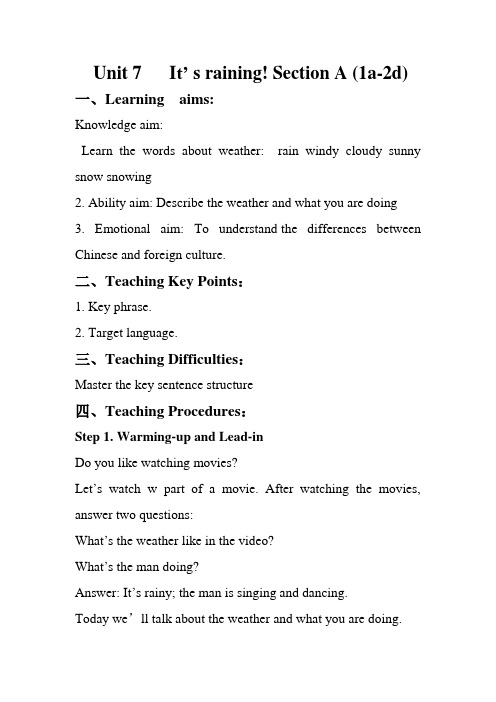
Unit 7 I t’ s raining! Section A (1a-2d) 一、Learning aims:Knowledge aim:Learn the words about weather: rain windy cloudy sunny snow snowing2. Ability aim: Describe the weather and what you are doing3. Emotional aim: To understand the differences between Chinese and foreign culture.二、Teaching Key Points:1. Key phrase.2. Target language.三、Teaching Difficulties:Master the key sentence structure四、Teaching Procedures:Step 1. Warming-up and Lead-inDo you like watching movies?Let’s watch w part of a movie. After watching the movies, answer two questions:What’s the weather like in the video?What’s the man doing?Answer: It’s rainy; the man is singing and dancing.Today we’ll talk about the weather and what you are doing.We’ll learn Unit 7. It’s raining.Step 2. Presentation1. Show some picturesT: What’s this in English? (It’s the sun.)2. Then show some other pictures.T: How’s the weather in the picture?Ss: It’s sunny.(In the same way, finish teaching the words “sun, cloud, wind, rain, snow”“windy, cloudy, raining, snowing”)Step 3. Listen and fill in the chartTask3 Practice1. Pair worksWork in pairs to practice the conversations:A: How’s the weather in……B: It’s ……2. Challenges the anchors (挑战主持人)Hello, everyone! I am... Today is Thursday. Here is the weather report. Shenyang is snowy today. Beijing is…. Thanks for your listening.Task4 ListeningT: People like doing different things in different weather. Show some pictures and guess “What is he/she doing?”Learn the phrases: cooking dancing playing computer games watching TVSleeping2. The weather is sunny today, Lucy’s family are doing different things.Lucy is talking on the phone.Listen to the tape and finish 2a and 2b.Task5practice1. Ask and answer questions in pairs. Talk about the people in Lucy’s family.A: What’s Uncle Joe/Jeff/Mary/Aunt Sally doing?B: He/She’s playing computer games/ playing basketball/ cooking/ watching TV2. Story telling: This is Lucy’s family. The weather is sunny today. Lucy is talking on the phone. Aunt Sarah is cooking…Task6 Role-play the conversation1. Read the conversation in 2d and answer the questions.1).What is Steve doing ?2).Is Steve's brother watching TV at home?2. Listen to the tape and read after the tape.3. Boys are Steve, and girds are Peter. Roles play the conversation.4. Role-play the conversation in pairs.Task7 Show pictures of Culture differencesTask8 Make a survey and do a report:五一马上到了,假设你想去外地旅游,打电话给你外地的朋友问候并调查当地的天气.Task9 Summary and homework1. Make up a dialogue about how to ask and answer weather.(必做)2. Write a weather report about the weather in different cities of Shandong province.(选做)Unit7 It’s raining一、用所给词的适当形式填空1、How’s the weather there? It's __________ (rain).2、The _________ is shining. It's_________ .(sun)3、There are a lot of________ in the sky. It's __________ .(cloud)4、It often ________ (rain) in summer in my hometown.5、The weather is________ (wind)and cold.6、--What_____ he _____(do)? --He is playing computer games.7、--What are you doing? -I'm_________ (watch)TV.二、选择填空( )1.______ Jeff like oranges?A. IsB. DoC. Does( )2. Aunt Sarah ______ every day.A. play computer gamesB. plays computer gamesC. is playing computer games( ) 3.-How''s the weather in Harbin? -It's ____.A. snowB. snowingC. snows( ) 4. Tom is ______ lunch.A. haveB. havingC. having三、句型转换1. I’m playing computer games. (变否定句)________ ______ ________ computer games.2. They are watching TV. (变一般疑问句)________ ________ watching TV?3. It’s cloudy. (对划线部分提问)________ is the weather?4. We are playing basketball. (对划线部分提问)________ are you ________?四、任务型阅读理解,阅读短文,完成文后练习We often talk about the weather. If we want to know about the weather, we can turn on the radio( 收音机) and listen to the weather report. We can also turn on the TV and watch the Weather Show. And we can ask other people in two different ways, “ What’s the weather like today?” or “ How is the weather today?” sometimes you can call at 121 for the weather.Now young people prefer (更喜欢) to surf the Internet or use the mobile phones(手机) for the weather.When it’s cold, we shiver and need to wear warm clothes and scarves. When its raining, we need raincoats or umbrellas. When it’s hot, we needa cool place and want to cold drink(饮料).1. If we want to know about the weather, we can ask other people in two different ways, “________________________?” or “ _____________________?”2.if we want to know about the weather, we can ___________________,we can also ________________________, we can ________________, and sometimes we can _______________________.3. The word “ shiver” is “___________________” in Chinese.4.. When it’s raining, we need _________________________________.5. When it’s hot, we need ___________________and want___________.学情分析天气的学习以及学习描述正在做的活动是与我们的日常生活紧密相关的话题,比较容易调动学生的学习积极性。
【人教版新目标】初一七年级英语下册《Unit 7》单元教案
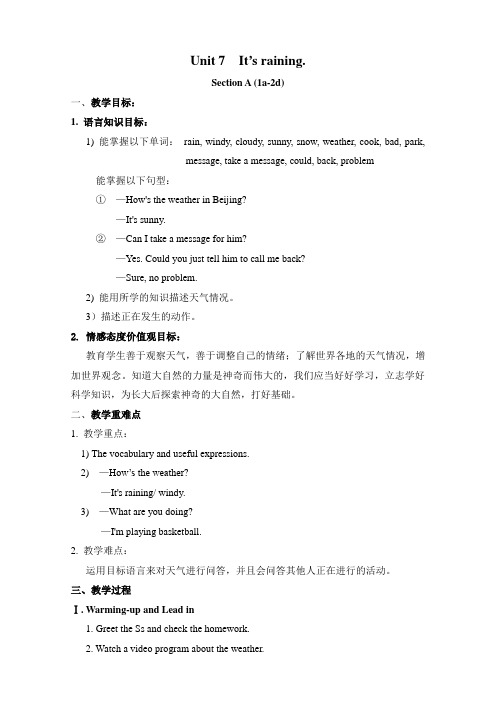
Unit 7 It’s raining.Section A (1a-2d)一、教学目标:1. 语言知识目标:1) 能掌握以下单词:rain, windy, cloudy, sunny, snow, weather, cook, bad, park,message, take a message, could, back, problem 能掌握以下句型:①—How's the weather in Beijing?—It's sunny.②—Can I take a message for him?—Yes. Could you just tell him to call me back?—Sure, no problem.2) 能用所学的知识描述天气情况。
3)描述正在发生的动作。
2. 情感态度价值观目标:教育学生善于观察天气,善于调整自己的情绪;了解世界各地的天气情况,增加世界观念。
知道大自然的力量是神奇而伟大的,我们应当好好学习,立志学好科学知识,为长大后探索神奇的大自然,打好基础。
二、教学重难点1. 教学重点:1) The vocabulary and useful expressions.2) —How’s the weather?—It's raining/ windy.3) —What are you doing?—I'm playing basketball.2. 教学难点:运用目标语言来对天气进行问答,并且会问答其他人正在进行的活动。
三、教学过程Ⅰ. Warming-up and Lead in1. Greet the Ss and check the homework.2. Watch a video program about the weather.Ⅱ. Presentation1. (Show some pictures of the weather)Let Ss look at the pictures and ask them how the weather is.Ss learn the new words and expressions with the help of the pictures.2. Look at the pictures in 1a. Then read the new words on the right. Ask the Ss tomatch the words with pictures.3. Check the answers.Ⅲ. Game (How's the weather?)1. (Showing some pictures on the big screen.) Ask Ss "How's the weather?"2. Ss guess and answer the question.Ⅳ. Listening1. Now let's look at the city names in the box in 1b. Please read after me.Ss read the cities after the teacher.2. Now, We’ll hear four conversations. Listen carefully, point out each city in thepicture as it comes upon the tape. Play the recording a second time. Ask Ss to write the name of the city in the picture of its weather.3. Check the answers.Ⅴ. Pair work1.Tell the Ss: If you are in one of the places in the picture above. Talk about theweather with your friends in another city on the phone.2. Make a model with a student like this:T: Hi! How's the weather in Beijing?S1: It's sunny.3. Ss work in pairs. Ask and answer about the weather in the cities.Ⅵ. Listening1. Work on 2a.Let's see what Joe's families are doing. Point to the 4 pictures.2. Ask Ss tell each person is doing in each picture. More attentions should be paidto the correct use of the Present Progressive Tense.3. Play the recording for the Ss to listen and number the pictures [1-4].4. Play the tape for Ss to check the answers.5. With the whole picture, get some Ss to tell the story of it.6. BrainstormingPlay the tape for another time. Then do a memory test.Ask Ss: What's Uncle Joe/Jeff/Mary/Aunt Sarah doing?What're Scott and Lucy doing?Is Jeff watching TV? etc.7. Let Ss match the names with the activities in 2b.Play the recording for the Ss to check the answers.Ⅶ. Pair work1. Look at the pictures and talk about the people in 2a with a partner.2. Ask a student the questions as a model:T: What's Uncle Joe doing?S1: He's playing basketball.3. Ss work in pairs. Ask and answer about the pictures.Ⅷ. Role-play1. Ask Ss to read the conversation and answer the questions:①What's Steve doing?②What's Rick's brother doing?Ss read the conversations and answer the questions. Then check the answers together.2. Let Ss role-play the conversation in pairs.IX. Language points.X. ExercisesHomework:一、总结有关天气的词汇。
Unit7-《It’sraining》优秀教学设计

1111・ Show two pictures of good weather and badweather .Ask the students to pay attention to the weather ・ Ask them to protect our world ・2. Play a turntable game ・T:How* s the weather inBeijing(Harbin/ Hong Kong/ Lhasa)?Ss :It' s warm(cold / hot / COO1)・discuss the different weather ・ 2・ Teacher click the button according to the turntable game ・ Students answer thequestion. 2. Students work in pairs to talk about theweather ・ 引出话题,提醒学生保护环境的重要性。
2、以转盘游戏来引 入将要学习的天气 新课特别贴切,在轻 松的气氛中即复习 了 一部分单词,乂活 跃了课堂。
Step 3 Presentation1・ Present pictures ofdifferent places to learn thenew words:Moscow/Boston/Syd ney/Toronto.2. 由去不同的城市旅行要 先了解当地天气情况,引出 天气的新单词:raining 、windy> sunny 、 snowing 、 cloud y.3. 结合天气图标认读单词, 叫学生完成连线题和游戏1・ Look at the pictures of new words on screen and learn the new words ・2・ Then ask Ss to read the new words one by one in lines ・3・ Ss work together to complete the tasksassigned by the teacher ・1、 通过不同城市的 地标建筑教授该城 市单词。
小学英语:二年级 Unit7 Weather 评课稿

小学英语新课程标准教材英语教案( 2019 — 2020学年度第二学期 )学校:年级:任课教师:英语教案 / 小学英语 / 小学二年级英语教案编订:XX文讯教育机构二年级 Unit7 Weather 评课稿教材简介:本教材主要用途为通过学习英语的内容,提高学生的语言技能,增加一项语言能力,有利于国际化的日常交流、生活、工作等,本教学设计资料适用于小学二年级英语科目, 学习后学生能得到全面的发展和提高。
本内容是按照教材的内容进行的编写,可以放心修改调整或直接进行教学使用。
今天下午又是青年教师俱乐部,统一看视频和写评课稿,我们英语统一意见后看了由青浦佳乐小学的沈晓菁执教的小学二年级的一堂weather课,收获很大,感触颇深,现就这堂课谈一下我的几点个人看法:沈老师的这堂课优点甚多,而且做到了以学生为本,培养学生多方面的能力,如语言表达能力,团结合作能力,观察力,创造力等。
主要有以下三个优点1、沈老师的个人素质和基本功都很扎实,语音语调纯正、自然,有亲和力,有丰富的表情和体态。
让人有一种耳目一新的感觉。
2、在单词教学中渗透语音知识。
这堂课中,每一个单词的引出教师都让学生通过单词的分音节朗读,最后拼出该单词的正确读音,让学生在听听看看中自然学会单词,而不是教师直接说出单词的读音,而是让学生有一个思考和拼读的过程,逐渐渗透和培养学生通过音节拼读单词的能力。
如这节课中,教学 winter这个单词,就是由win+ter组合构成winter这个单词,再如教学snow时,通过学生熟悉的yellow和slow中ow的发音引出 snow的发音。
3、连贯性,整体性强,由易到难思路清晰。
整节课都围绕winter进行展开,先是让学生描述winter的特点,接着是winter可以穿的衣服,到最后winter可以做的运动,步步深入,显得很自然。
如在冬天可以做的活动这一环节,学生说了自己的活动后,教师接着由自己喜欢做的活动i like to see snow引出snow这个单词,接着是雪花snowflake和a snowball 的引出,以及让学生造词和造句等活动 a snow___,i can make a snow____的设计,培养了学生举一反三的能力和一定的创造力,直到最后一个拓展i can also make a rhyme的呈现也是那么的自然和富有创造力。
二年级英语上册 Unit7 Weather(1-3)教案 沪教牛津版
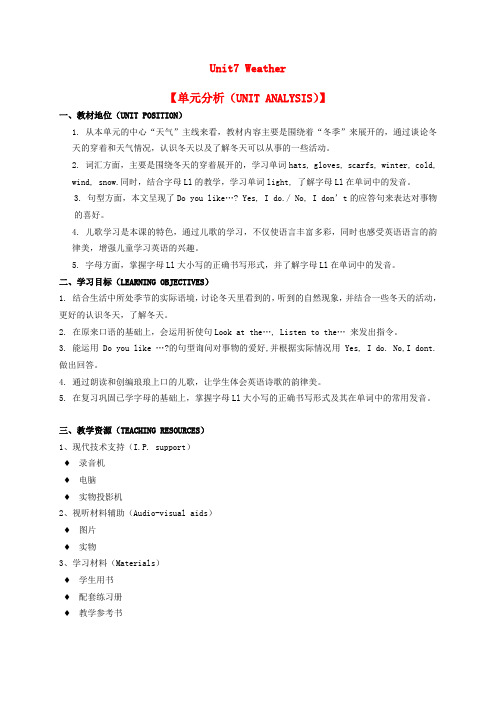
Unit7 Weather【单元分析(UNIT ANALYSIS)】一、教材地位(UNIT POSITION)1. 从本单元的中心“天气”主线来看,教材内容主要是围绕着“冬季”来展开的,通过谈论冬天的穿着和天气情况,认识冬天以及了解冬天可以从事的一些活动。
2. 词汇方面,主要是围绕冬天的穿着展开的,学习单词hats, gloves, scarfs, winter, cold,wind, snow.同时,结合字母Ll的教学,学习单词light, 了解字母Ll在单词中的发音。
3. 句型方面,本文呈现了Do you like…? Yes, I do./ No, I don’t的应答句来表达对事物的喜好。
4. 儿歌学习是本课的特色,通过儿歌的学习,不仅使语言丰富多彩,同时也感受英语语言的韵律美,增强儿童学习英语的兴趣。
5. 字母方面,掌握字母Ll大小写的正确书写形式,并了解字母Ll在单词中的发音。
二、学习目标(LEARNING OBJECTIVES)1. 结合生活中所处季节的实际语境,讨论冬天里看到的,听到的自然现象,并结合一些冬天的活动,更好的认识冬天,了解冬天。
2. 在原来口语的基础上,会运用祈使句Look at the…, Listen to the…来发出指令。
3. 能运用Do you like …?的句型询问对事物的爱好,并根据实际情况用Yes, I do. No,I dont.做出回答。
4. 通过朗读和创编琅琅上口的儿歌,让学生体会英语诗歌的韵律美。
5. 在复习巩固已学字母的基础上,掌握字母Ll大小写的正确书写形式及其在单词中的常用发音。
三、教学资源(TEACHING RESOURCES)1、现代技术支持(I.P. support)♦录音机♦电脑♦实物投影机2、视听材料辅助(Audio-visual aids)♦图片♦实物3、学习材料(Materials)♦学生用书♦配套练习册♦教学参考书四、课时划分(PERIOD DIVISION)Unit 7 Weather第一课时(1ST PERIOD)一、主要新授内容(new contents)Letter----LlLet’s learn----hats, gloves, scarfs, winter, light, summer*二、学习目标(Objectives)1. 联系单词light,学习字母Ll, 掌握它在单词中的常用发音,并且能掌握字母Ll 正确的大小写书写形式。
weather 教学设计(共3篇)
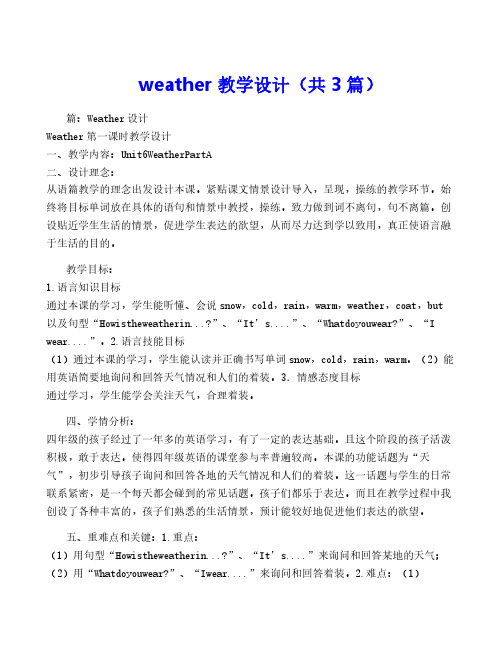
weather教学设计(共3篇)篇:Weather设计Weather第一课时教学设计一、教学内容:Unit6WeatherPartA二、设计理念:从语篇教学的理念出发设计本课。
紧贴课文情景设计导入,呈现,操练的教学环节。
始终将目标单词放在具体的语句和情景中教授,操练。
致力做到词不离句,句不离篇。
创设贴近学生生活的情景,促进学生表达的欲望,从而尽力达到学以致用,真正使语言融于生活的目的。
教学目标:1.语言知识目标通过本课的学习,学生能听懂、会说snow,cold,rain,warm,weather,coat,but 以及句型“Howistheweatherin...?”、“It’s....”、“Whatdoyouwear?”、“I wear....”。
2.语言技能目标(1)通过本课的学习,学生能认读并正确书写单词snow,cold,rain,warm。
(2)能用英语简要地询问和回答天气情况和人们的着装。
3.情感态度目标通过学习,学生能学会关注天气,合理着装。
四、学情分析:四年级的孩子经过了一年多的英语学习,有了一定的表达基础。
且这个阶段的孩子活泼积极,敢于表达。
使得四年级英语的课堂参与率普遍较高。
本课的功能话题为“天气”,初步引导孩子询问和回答各地的天气情况和人们的着装。
这一话题与学生的日常联系紧密,是一个每天都会碰到的常见话题。
孩子们都乐于表达。
而且在教学过程中我创设了各种丰富的,孩子们熟悉的生活情景,预计能较好地促进他们表达的欲望。
五、重难点和关键:1.重点:(1)用句型“Howistheweatherin...?”、“It’s....”来询问和回答某地的天气;(2)用“Whatdoyouwear?”、“Iwear....”来询问和回答着装。
2.难点:(1)weather的发音;(2)理解raining、snowing表示正在发生的天气状况。
3.关键:通过呈现下雪、下雨的动态图并配合背景音效,创设逼真的情景,让学生理解并学会运用“It’ssnowing.”、“It’sraining.”来描述正在发生的天气状况。
- 1、下载文档前请自行甄别文档内容的完整性,平台不提供额外的编辑、内容补充、找答案等附加服务。
- 2、"仅部分预览"的文档,不可在线预览部分如存在完整性等问题,可反馈申请退款(可完整预览的文档不适用该条件!)。
- 3、如文档侵犯您的权益,请联系客服反馈,我们会尽快为您处理(人工客服工作时间:9:00-18:30)。
Unit 7 Weather 单元分析教学设计Teaching design of unit 7 weather unit analysi s
Unit 7 Weather 单元分析教学设计
前言:小泰温馨提醒,英语作为在许多国际组织或者会议上都是必需语言,几乎所有学校
选择英语作为其主要或唯一的外语必修课。
英语教学涉及多种专业理论知识,包括语言学、第二语言习得、词汇学、句法学、文体学、语料库理论、认知心理学等内容。
本教案根据
英语课程标准的要求和针对教学对象是小学生群体的特点,将教学诸要素有序安排,确定
合适的教学方案的设想和计划、并以启迪发展学生智力为根本目的。
便于学习和使用,本
文下载后内容可随意修改调整及打印。
unit 7 weatherxxx学院朱 xxx小学施玮
菁【单元分析(unit analysis)】一、教材地位(unit position)1.从本单元的中心“天气”主线来看,教材内容主要
是围绕着“冬季”来展开的,通过谈论冬天的穿着和天气情况,
认识冬天以及了解冬天可以从事的一些活动。
2.词汇方面,主要是围绕冬天的穿着展开的,学习单词hats, gloves, scarfs, winter, cold, wind, snow.同时,结合字母ll 的教学,学习单词light, 了解字母ll在单词中的发音。
3.句型方面,本文呈现了do you like…? yes, i do./ no,
i don’t的应答句来表达对事物的喜好。
4.儿歌学习是本课的特色,通过儿歌的学习,不仅使语言丰
富多彩,同时也感受英语语言的韵律美,增强儿童学习英语的兴趣。
5.字母方面,掌握字母ll大小写的正确书写形式,并了解
字母ll在单词中的发音。
二、学习目标(learning objectives)
1.结合生活中所处季节的实际语境,讨论冬天里看到的,听到的
自然现象,并结合一些冬天的活动,更好的认识冬天,了解冬天。
2.在原来口语的基础上,会运用祈使句look at the…, listen to the… 来发出指令。
3.能运用do you like …?的句型询问对事物的爱好,并根据实际情况用yes, i do. no,i dont.做出回答。
4.通过朗读和创编琅琅上口的儿歌,让学生体会英语诗歌的
韵律美。
5.在复习巩固已学字母的基础上,掌握字母ll大小写的正
确书写形式及其在单词中的常用发音。
三、教学资源(teaching resources)1、现代技术支持(i.p. support)¨录
音机¨电脑¨实物投影机2、视听材料辅助(audio-visual aids)¨图片¨实物3、学习材料(materials)¨学生用
书¨配套练习册¨教学参考书四、课时
划分(period division)本单元建议分六课时完成。
periodtitlecontents1st periodletters let’s
learn letter----lllet’s learn----hats, gloves, scarfs, winter, light, summer*2nd period let’s actlet’s
learn---wind, snowlet’s act---- look at
the…listen to the…3rd period let’s play let’s learn---winter, cold, blowslet’s play--- a
miming game 4th periodlet’s talk let’s talk---do you like…? yes, i do. no, i don’t.5thperiodlet’s
enjoy let’s enjoy---rhyme6th periodrevision
-------- Designed By JinTai College ---------。
